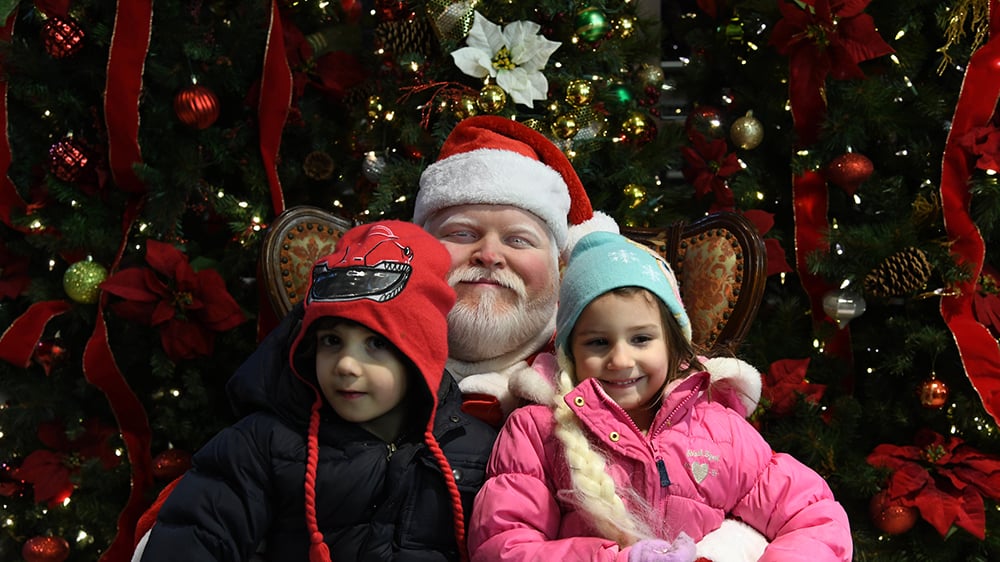The McNichol Room comes alive with a captivating symphony of colors, an intricate masterpiece...
The Imagination of the Holiday Season

Children use their imagination in several ways to function socially, mentally, and most importantly, creatively. Imagination, the act, or power of visualizing something that does not exist, morphs children into especial people all while expanding their creative ability. The holiday season, specifically Christmas, impacts children to a great deal and encourages them to believe in something that correlates with their ability to grow into fully fledged individuals. For this reason, the celebration of Christmas and the fictional presence of the holiday’s symbolic figure, Santa Clause, should remain a vital importance in children’s lives.
The holidays are known to be the building blocks of family traditions and gatherings. Traditions, or holiday rituals, that typically start at a young age are the result of children’s excitement for Christmas magic. It conveniently gives them an outlet of imagination occurring the same time each year, producing a lifetime worth of joy.
“Many of the traditional holiday rituals...require kids to suspend disbelief and embrace the fantastic—and doing so can be a boon for their mental development” (Alyssa Sybertz, 2021). There are dozens of traditional activities such as letters to Santa, Elf on the Shelf, decorating the Christmas tree, and watching Christmas films that enhance the true meaning of Christmas itself. Besides the gift-giving, children also associate the reunion of family with positive and warm feelings that not only they themselves feel, but also those they are surrounded by as well.
Love and celebration are germane to keeping up with the growth of children around this time of year. “Family traditions are important for children. They strengthen family bonds, provide a sense of belonging for children and create memories that last a lifetime. More importantly, family traditions tell children a story about who they are and the importance of family” (Elena Merenda and Nikki Martyn, n.d.). Just like any other person would, children specifically take interest and chose to take part in things that are factors in their happiness. Nothing makes a kid happier than receiving gifts, being around the people they love most, and taking part in activities that continue throughout many years.
Children live upon a thin line of imagination and reality. Santa Clause, a distinctive figure of Christmas, is the definition of the holiday history itself. Adults support the idea of this legend, Kris Kringle, and spread positive white lies to brace the hopes and dreams children withhold around the holidays. “He became known as the protector of children and was admired for his kindness” (Elena Merenda and Nikki Martyn, n.d.). As a child, believing in fictional things without physically visualizing them is developmentally beneficial. In other words, imagination and fantasy are healthy methods of learning life lessons.
Being serious about all aspects of life is not necessary, nor is it significant to children who are mostly unaware of common morals anyway. “Listen, all we are trying to do is give Charlie a firm grasp on reality...That's a good idea. You do not want kids runnin' around usin' their imaginations” (Leo Benvenuti Steve Rudnick, 1994). The Christmas spirit allows children to collect a sense of kindness, forgiveness, and an understanding of others, just as Santa Clause is portrayed. Allowing children to feel comfortable believing in Santa allows a form of compassion to grow within them and continue to grow even after the holiday season.
There are multiple online and self-employed platforms that support the idea of Santa Clause flying around the world with his magical reindeer, going from home to home, and filling up the floors beneath Christmas trees with bundles of gifts overnight. The power of Christmas magic is provided just for the prime happiness of children all over. “From 2 A.M. on Christmas Eve until 3 A.M. on Christmas Day Mountain time, approximately 1,200 volunteers handle more than 12,000 emails and over 70,000 calls to the hotline (877-HI-NORAD) from more than 200 countries and territories” (William D. Crump, 2013).
The harmless fiction presented during the holidays fuels the desired excitement of believing in a person who brings happiness to all and creates a largely known positive impact. “Christmas is quite literally a magical time in this universe with ‘Christmas Spirit’ being a powerful force that prevents the world from descending into darkness” (Craig McKenzie, 2020). Things as large as social platforms are an instant dopamine trigger in children and give them even more of a reason to fancy the ideas of make-believe.
Furthermore, children could never disregard the infamous quote, “He sees you when your sleeping, He knows when you’re awake, He knows if you’ve been bad or good, So be good for goodness sake!” (J. Coots and Henry Gillespie, 1934). The holiday season is a reward for good behavior by children, knowing that if they are good, they will be receiving a superb Christmas. Over the years, despite the time of the season, adults have unconsciously correlated Santa and Christmas based on the behavior of their children. Santa, despite his graceful impact on children, is used by parents as disciplinary consumer who will only respect children who aren’t naughty. Although it may sound creepy, the fictional thought of someone watching your every move creates a sense of discipline and respectfulness for a child. They begin to act as if they have something to prove.
Anything is possible with the help of a little Christmas spirit. A good man, with good intentions, brings good things, from the warmth of his heart. The celebration of Christmas brings the best out of everyone, no matter the age. Whether they are naughty or nice, pure souls conform to the importance of imagination. The use of imagination is crucial to social development, and the holidays create the experiences that shape childhood.




